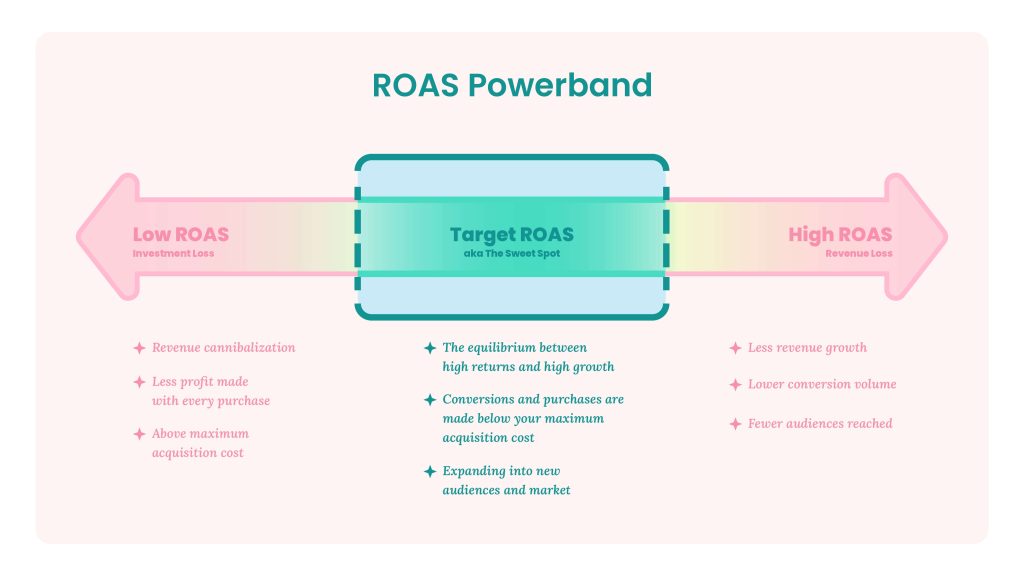Serious question: Do you know how well your digital ads are REALLY performing?
Return on Ad Spend (ROAS) is the metric that unlocks your campaign’s success.
In this short guide, we’ll explore what ROAS is, how to calculate it, what qualifies as a “good” ROAS, and how to balance immediate returns with long-term growth. Let’s dive in and elevate your ad strategy to new heights!
What is Return on Ad Spend (ROAS)?
Return on Ad Spend (ROAS) is a crucial metric for gauging the success of your digital advertising campaigns. It measures the revenue generated for every dollar spent on advertising, highlighting the efficiency of your ad spend.
A positive ROAS indicates that your campaigns are effectively reaching the right audiences and converting them into customers, resulting in significant revenue compared to the investment made.
How Do I Calculate ROAS?
Calculating your Return on Ad Spend is straightforward: divide your total revenue from ads by your total ad spend.
For example, if your ad campaign generates $40,000 in revenue and you spent $10,000 on ads, your ROAS would be 4:1. This means you earn $4 for every $1 spent.
What is a Good ROAS?
Determining a “good” ROAS isn’t one-size-fits-all; it varies by industry, brand, advertising strategy, sales cycle, and conversion goals.
If you search online, the general consensus finds that a 3:1 to 4:1 ROAS to be great, while for some other industries, it might fall short.
For instance, startups with tight budgets may need higher Returns on Ad Spend to stay profitable, while growth-focused eCommerce brands can afford higher advertising costs and still be highly successful, even with a lower Return on Ad Spend.
In retail, a ROAS of 5:1 might be necessary, whereas in SaaS, a 3:1 ratio might suffice. Service-based businesses like consulting might require a 6:1 ROAS to cover higher operational costs.
Defining your budget and understanding your profit margins are key to setting realistic goals. Businesses with larger margins can survive with a lower ROAS, whereas those with smaller margins should maintain low advertising costs to achieve profitability.
However, focusing exclusively on maximizing ROAS can be a double-edged sword. This metric is reliant on multiple factors, after all!

Advantages of a High ROAS
- Efficient Spending: A high ROAS means you are generating more revenue for every dollar spent, thereby increasing your profit margins overall. Strong Returns on Ad Spend indicate that you are maximizing immediate returns.
- Resource Allocation: Helps focus on high-performing channels and strategies, driving the best results.
- Competitive Edge: Consistently high ROAS provides a significant advantage, maintaining profitability and market competitiveness.
Woo! Getting more bang for the buck is great. But, there are actually some downsides to an overly healthy ROAS.
Disadvantages of a High ROAS
- Neglecting Prospecting: An emphasis on channels that drive high Return on Ad Spend often target purchase-ready audiences, overlooking the top-of-funnel activities necessary for identifying and nurturing new customers. Without new prospects, you might be ignoring future revenue streams!
- Market Saturation: Heavy reliance on high-ROAS channels can lead to market saturation, with diminishing returns as the same audience experiences ad fatigue.
- Short-Term Focus: Prioritizing a high Return on Ad Spend can shift focus to short-term gains, potentially missing opportunities for long-term growth and lasting customer relationships.
Achieving a Balanced Strategy
- Create a Holistic Ad Approach: Balance ad channels with high ROAS potential along with prospecting campaigns to ensure a steady influx of new leads and maintain efficient spending, building a sustainable sales funnel. Once you know your target audience like the back of your hand, we recommend creating multiple touchpoints throughout the customer journey by leveraging a variety of ad channels.
- Focus on Comprehensive Metrics: It’s important to consider the relationship between your ROAS and other metrics, such as revenue, conversion volume, and conversion rate to understand if there is a market opportunity to increase conversion share, or if it’s time to fall back on spending to prioritize profitability.
- Adapt and Expand: Continuously monitor and adjust your strategy to explore new audiences and markets, sustaining growth and maximizing ad spend by reaching untapped markets.
How War Room Can Help Optimize Your ROAS
At War Room, we understand the importance of managing ad budgets to achieve both short-term and long-term goals. With over a decade of programmatic experience and a diverse client base, we’ve learned that balancing high-yielding ROAS channels with prospecting efforts yields the most sustainable results.
- Strategic Budget Allocation: We help clients strategically distribute their ad spend to maximize efficiency and ensure growth. This includes investing in channels with strong ROAS potential for immediate returns and prospecting campaigns to build a future customer pipeline.
- Holistic Approach to Paid Ads: At War Room, we act as an extension of your marketing team, managing everything from programmatic ad campaigns and technical marketing to creative services. We handle the entire process—from setting up campaigns and managing data ecosystems and warehousing to crafting compelling copy, ad designs, and landing pages. We ensure every detail is covered, providing comprehensive reports and insights at the end of each campaign to drive continuous improvement and success.
Our approach incorporates paid media metrics, with market trends and analyses to build a complete view of campaign performance. - Proven Results: With hands-on campaign monitoring and management, along with our proprietary ad tech platform, Kedet, we ensure precise targeting, real-time data analysis, and optimized ad performance.
To sum it up…
While achieving a strong ROAS is fantastic, focusing solely on this metric can lead to challenges down the road. Balancing efforts between converting and prospecting ensures sustainable growth and a healthy sales funnel. By doing so, you maximize immediate returns and secure future revenue streams. It’s about enjoying the best of both worlds—quick wins today and lasting success tomorrow. Keep your eye on the long-term game, and your business will thrive!












